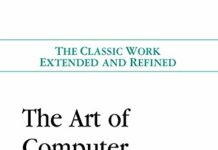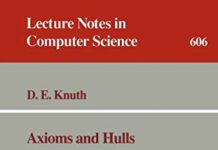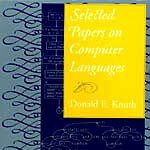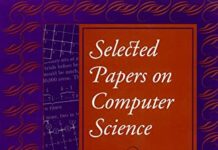
Ebook Info
- Published: 1997
- Number of pages: 672 pages
- Format: PDF
- File Size: 35.77 MB
- Authors: Donald E. Knuth
Description
The bible of all fundamental algorithms and the work that taught many of today’s software developers most of what they know about computer programming.–Byte, September 1995 I can’t begin to tell you how many pleasurable hours of study and recreation they have afforded me! I have pored over them in cars, restaurants, at work, at home… and even at a Little League game when my son wasn’t in the line-up.–Charles LongIf you think you’re a really good programmer… read [Knuth’s] Art of Computer Programming… You should definitely send me a resume if you can read the whole thing.–Bill GatesIt’s always a pleasure when a problem is hard enough that you have to get the Knuths off the shelf. I find that merely opening one has a very useful terrorizing effect on computers.–Jonathan LaventholThis first volume in the series begins with basic programming concepts and techniques, then focuses more particularly on information structures–the representation of information inside a computer, the structural relationships between data elements and how to deal with them efficiently. Elementary applications are given to simulation, numerical methods, symbolic computing, software and system design. Dozens of simple and important algorithms and techniques have been added to those of the previous edition. The section on mathematical preliminaries has been extensively revised to match present trends in research.Ebook (PDF version) produced by Mathematical Sciences Publishers (MSP),http://msp.org
User’s Reviews
Reviews from Amazon users which were colected at the time this book was published on the website:
⭐All three volumes of The Art of Computer Programming (TAOCP), are classic. Each is a book that every CS student should try to study diligently reimplementing example after example. Not many will succeed to finish even a half of one volume, but if you do please buy all three of them and think about post-graduate studies :-).I think the most important is to study the Vol 1. It gives enough exposition to the Donald Knuth style and brilliant thinking. While the content is definitely important it is the level of thinking of the author that represents the main value of the book: you instantly understand the book was written by a great scientist and it does not matter much that now the contents of most chapters can be significantly improved using more modern sources. After all Vol 1 is more then a 30 years old book (it is older then Unix) and as such it should be outdated (we all believe in progress, don’t we)… And it is not surprising that parts of Vol 1 on of TAOCP today look completely out of touch with reality especially MIX, the CPU instruction set that is used in all volumes.Actually MIX instruction set (and thus assembler) was outdated even when the book was first published and more reflects unique Knuth’s background with IBM 650. It was far from the state of hardware development even in late 60th when the first volume was published, the period when IBM/360 was the king of the hill.Now IBM 650, a 1,966 lb machine that consumed almost 30 Kw of electricity looks more like a primitive calculator than a real computer: typical installation has the memory of just 10,000 decimal digits ( 1,000 words; 10 digit per word).It’s really sad that Knuth did not adopt System 360 architecture and PL/360 assembler (Wirth’s structured assembler for S/360) for his books but we can do nothing about it. Still this is a book about timeless truths, not the book about the resent CS fashion like Java or you name it :-). It actually can serve as a perfect antidote against any current CS fashion.And Knuth does provide pseudocode with his natural language algorithm description. And natural language pseudocode has an important advantage over ‘structured pseudocode. The problem with a “structured pseudocode” is that the set of control structures is fixed and may not reflect the needs of a particular algorithms (branching out of loop is a common problem that is not addressed by structured programming well). Moreover it can cripple the algorithm by enforcing unnatural control structures, the structures that are absent in it but might be present in more modern languages. For example Perl has an interesting set of control structures that is superior to C. But even “Perl control structures set” can be improved further.That’s why assembler language is preferable: it never obscures “natural” control structures for each algorithms, structures that one day can be mapped into some new elegant language construct. Also as one review noted “sometimes high level languages with all their abstractions make things look more complex than they need be.”I would like to stress it again that each volume is very difficult to read; you really need to work on each chapter by reimplementing the examples that Knuth gives in your favorite language (assembler might help but is not essential).Mathematical considerations as for average and worst running time of a particular algorithm can be largely ignored during the first couple of years of study of this book. Actually most mathematics in Vol. 1 can (and probably should) be initially completely ignored. See Softpanorama Classic Computer Books for more information.On the negative side this is an overpriced book, if we are talking about students budget. To save money you can buy one of the first editions: there is not that much difference in content to justify the differences in price. The differences do not interfere with the study of the book. Knuth did an excellent work the first time he published each volume and for a significant improvement we probably need another century and another person.
⭐Yes, it is risky to review an author such as Knuth. But, certain things must be said and it seems like I may be the only one to say them. First, Knuth’s books, including this new addition are invaluable resources of wisdom. Their depth and tenacity are rarely found elsewhere in our industry. That being said, I believe Knuth has really missed a big mark in this new addition.My chief complaint of all of Knuth’s “Art of” series is his incessant use of “MIX”. MIX is Knuth’s homebrew assembly language he uses to analyse the computer algorithms he describes. When Knuth first wrote the “Art of” series, assembly language was thankfully dying. 20 years later, no one but Knuth would even consider writing a book filled with such gibberish. There is no possible way at the end of the 1990s that this nonsense can be justified. Knuth has really missed the mark by insisting on having MIX in his books. What about C or C++, Pascal, BASIC, or even his own high-level psuedo-language? Here’s the “God” of computer programming pushing this wretched gobbledygook on us. I can only attribute his horrid fascination with MIX to one of three things: Laziness (he doesn’t want to rewrite his analysis – if this is true, then the new additions might need to be re-titled “The Art of Milking a Good Thing”), pride (he just can’t give up his assembly language bastard-child he created), or ignorance. Either way, none of these are good justifications for why us plain mortals have to wade through this mine field of MIXed manure. Get with it Don! Come down to our level, be a little bit humble and give us a decent high-level language analysis of your favorite algorithms. MIX – R.I.P.
⭐This was purchased as a requested item by my son-in-law for his Christmas present. He is a computer programer and would not have requested this item if it was not a superior product. If I can afford it, I will buy him volume II this year.
⭐The Kindle version of this book consists entirely of scanned images of pages. Presented as images rather than text, unlike any other KIndle book I’ve purchased, prevents text from being selected (because it’s an image of text) and makes it so that zooming in, in order to actually read the text, requires panning around as you read (you can only re-size the entire image of a page, not the text) — this is simply an un-usable ripoff (fraudulent, even, as other e-books are in text format not images, bait-and-switch), shame on you Amazon for charging money for this travesty, instead of giving this renowned and important work the treatment it deserved.
⭐This book is one of the hardest comp-sci books I’ve tried to go through. Like anything else in life, what you put into this book is what you get out of it. It can go a little over my head from time to time, but really, that’s a good thing. You’ll never learn to swim if you stand in the shallow end of the pool all your life.
⭐Bought for my grandson. His words, “yes it was real good so far still reading”
⭐Donald E. Knuth – I am your biggest fan and this is one of my favorite books on algorithms. Don’t be intimated by its size and the number of volumes – this is a life work of one of the most brilliant computer scientists of all times. Love this book, thank you Donald Knuth.
⭐I need this book to help me with programming. Working system programming and I hope this should help. Mostly C.
⭐Without a doubt this is an outstanding book; each passage is carefully written and structured so as to build up a complete view of a topic. As I read it I not only felt I was gaining understanding but confidence; many textbooks serve a reference – just a huge splurge of knowledge with no consideration given to how a pupil is going to digest it. Knuth’s book is totally different in that he has very carefully considered the structuring, pitching, breakdown and discussion of a topic at every stage to ensure it is digestible for his reader. Obviously the content still gets the grey cells working but it’s about as readable an academic book I think you’ll get.One watch-out; although this is a Kindle edition it is not compatible with some readers; I could only read this on my PC.
⭐The content cannot be questioned, this is a classic book on computing. My only concern is the quality of the kindle version. I knew beforehand that it does not display on the kindle, but only via the various apps available. However I would have expected the presentation to be better quality. It looks like a poor quality fax scan of a print edition. As the original was produced using Tex, I would have thought a better quality could have been produced. However, the kindle version is very cheap compared to the paper version so I only knocked off one star.
⭐It’s a great book that teaches you the fundamental of computer engineering and a morr mathematical way of thinking on low level computer operations and algorithms
⭐Very happy with this purchase: Book in very good condition, recent edition – seems good value. Carefully packed and promptly dispatched. Thankyou.
⭐Great book, beautifully made and a triumph of content over form.
Keywords
Free Download The Art of Computer Programming: Volume 1: Fundamental Algorithms 3rd Edition in PDF format
The Art of Computer Programming: Volume 1: Fundamental Algorithms 3rd Edition PDF Free Download
Download The Art of Computer Programming: Volume 1: Fundamental Algorithms 3rd Edition 1997 PDF Free
The Art of Computer Programming: Volume 1: Fundamental Algorithms 3rd Edition 1997 PDF Free Download
Download The Art of Computer Programming: Volume 1: Fundamental Algorithms 3rd Edition PDF
Free Download Ebook The Art of Computer Programming: Volume 1: Fundamental Algorithms 3rd Edition



